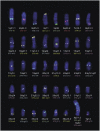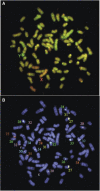Chromosome aberrations in canine multicentric lymphomas detected with comparative genomic hybridisation and a panel of single locus probes
- PMID: 14562028
- PMCID: PMC2394339
- DOI: 10.1038/sj.bjc.6601275
Chromosome aberrations in canine multicentric lymphomas detected with comparative genomic hybridisation and a panel of single locus probes
Abstract
Recurrent chromosome aberrations are frequently observed in human neoplastic cells and often correlate with other clinical and histopathological parameters of a given tumour type. The clinical presentation, histology and biology of many canine cancers closely parallels those of human malignancies. Since humans and dogs demonstrate extensive genome homology and share the same environment, it is expected that many canine cancers will also be associated with recurrent chromosome aberrations. To investigate this, we have performed molecular cytogenetic analyses on 25 cases of canine multicentric lymphoma. Comparative genomic hybridisation analysis demonstrated between one and 12 separate regions of chromosomal gain or loss within each case, involving 32 of the 38 canine autosomes. Genomic gains were almost twice as common as losses. Gain of dog chromosome (CFA) 13 was the most common aberration observed (12 of 25 cases), followed by gain of CFA 31 (eight cases) and loss of CFA 14 (five cases). Cytogenetic and histopathological data for each case are presented, and cytogenetic similarities with human non-Hodgkin's lymphoma are discussed. We have also assembled a panel of 41 canine chromosome-specific BAC probes that may be used for accurate and efficient chromosome identification in future studies of this nature.
Figures



References
-
- Alizadeh AA, Eisen MB, Davis RE, Ma C, Lossos IS, Rosenwald A, Boldrick JC, Sabet H, Tran T, Yu X, Powell JI, Yang L, Marti GE, Moore T, Hudson J, Lu L, Lewis DB, Tibshirani R, Sherlock G, Chan WC, Greiner TC, Weisenburger DD, Armitage JO (2000) Distinct types of diffuse large B-cell lymphoma identified by gene expression profiling. Nature 403: 6769 503–511 - PubMed
-
- Breen M, Thomas R, Binns MM, Carter NP, Langford CF (1999a) Reciprocal chromosome painting reveals detailed regions of conserved synteny between the karyotypes of the domestic dog (Canis familiaris) and human. Genomics 61: 145–155 - PubMed
-
- Breen M, Bullerdiek J, Langford CF (1999b) The DAPI banded karyotype of the domestic dog (Canis familiaris) generated using chromosome-specific paint probes [published erratum appears in Chromosome Res (1999) 7: 575]. Chrom Res 7: 401–406 - PubMed
-
- Breen M, Jouquand S, Renier C, Mellersh CS, Hitte C, Holmes NG, Cheron A, Suter N, Vignaux F, Bristow AE, Priat C, McCann E, Andre C, Boundy S, Gitsham P, Thomas R, Bridge WL, Spriggs HF, Ryder EJ, Curson A, Sampson J, Ostrander EA, Binns MM, Galibert F (2001) Chromosome-specific single locus FISH probes allow anchorage of an 1,800 marker integrated radiation-hybrid/linkage map of the domestic dog (Canis familiaris) genome to all chromosomes. Genome Res 11: 1784–1795 - PMC - PubMed
-
- Carter RF, Kruth SA, Valli VEO, Dubé ID (1990) Long-term culture of canine marrow: cytogenetic evaluation of purging of lymphoma and leukemia. Exp Haematol 18: 995–1001 - PubMed
Publication types
MeSH terms
Grants and funding
LinkOut - more resources
Full Text Sources
Other Literature Sources
Medical

